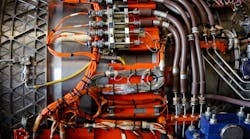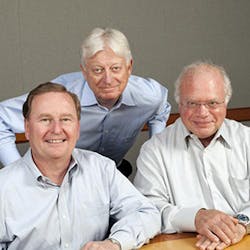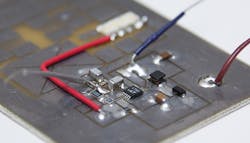Linear Technology was not looking for buyers when Analog Devices offered $14.8 billion to acquire the company and its library of power management circuit designs. On Tuesday, however, the companies announced that the deal had been signed, approved by both boards, and sent to regulators for review.
That the company accepted the deal was surprising to an industry familiar with its engineering culture, disdain for corporate matchmaking, and fanaticism for analog design. On social media and online forums, engineers reacted with criticism of the deal’s inevitable culture clash and questions about the fate of products, customer support, and the popular LTSpice circuit simulation software.
So why did Linear Technology agree to the $14.8 billion deal?
The short answer is that it’s a windfall for Linear Technology shareholders. The deal represents almost 10 times the chipmaker’s revenues in 2015 – one of the highest multiples paid in the semiconductor industry in the last decade. Shareholders will be paid $46 and around one-fourth of an Analog Devices share for each stock.
According to Robert Swanson, who helped establish Linear Technology in 1981 and serves as the executive chairman, the price was too high to brush off. Taking the deal far outweighed the idea of keeping the business and famously high profit margins, which it makes from selling analog chips to automakers and factories.
“I think what pushed us over there was, frankly, we are a public company. They have fiduciary responsibilities, and the offer was so compelling,” Swanson said in a conference call with financial analysts on Tuesday. “It just turned out to be a deal we couldn’t turn down.”
But in an industry where intellectual properties have been thrown around like trading cards, the terms were a little murkier than other recent chip deals. In the conference call, the two sides sketched out the long negotiations about Linear’s culture that preceded the deal and how it might be preserved under new management. While the final decision might have been motivated by shareholder responsibilities, the fate of Linear's culture clearly weighed on the deal.
For years, Linear Technology has been a breeding ground not only for high-performance circuits but also for new generations of analog engineers. It has built a reputation as an engineering-driven company, carving out time every week to hear engineers pitch new designs and expecting them to interact directly with customers. It has such high retention that Linear Technology has called itself “the company that no one leaves.”
“We talked extensively about what he's paying for, and he understands that clearly,” Swanson said about his conversations with Vincent Roche, Analog Devices’ chief executive. “Our people are our most valuable assets. I am incredibly proud of Linear’s team, and I am gratified that Vince is well aware of how lucky he is to welcome them into the analog family.”
Neither Swanson nor Robert Dobkin, Linear Technology’s co-founder and chief technology officer, were interviewed for this article. Roche was also not interviewed.
Merging the two chipmakers is not without its technical merits. Analog Devices and Linear Technology are two of the biggest makers of circuits for translating things like sound, video, and radio signals into digital language. Analog is the industry's biggest supplier of data converters, while Linear has focused on power management. These products could be combined with wireless chips to create systems that gather data from vehicle sensors, factory equipment, and city infrastructure.
The cultural crossover was less clear. But executives on both sides said that the engineering-driven culture at both companies would smooth out the merger. "I think we have cultures that are very similar relative to innovation," said Swanson. "I think that's the reason this is a combination that can work better than any that I've seen in the past."
Linear Technology was founded 16 years after Analog Devices was established in 1965. The startup quickly turned into a bastion for analog design, in an industry shifting toward digital circuits with the rise of personal computers. Its first employees were defectors from other Silicon Valley companies — including National Semiconductor, where Swanson served as vice president for analog design — that had been leaving analog behind.
Swanson’s exit created a vacuum that sucked in other analog gurus. These included Dobkin, George Erdi, and Bob Widlar, a former Fairchild Semiconductor engineer who later became known as the “god of the operational amplifier.” The initial migration turned Linear Technology into a destination for analog engineers and eventually into something like an apprentice program for students of the analog craft.
Linear Technology has leaned on the expertise passed through its ranks. For most of his career with the company, Swanson rejected the idea of buying new technology through big acquisitions. Instead, he favored developing new circuits in-house. Linear has only made one acquisition in its history — Dust Networks, a wireless sensor networking company, in 2011.
Linear Technology has around 4,865 employees worldwide, a little more than half the 9,000 workers at Analog Devices. What will happen to the combined engineering team remains unclear. Both companies have overlapping products in power management, amplifiers, interface chips, and data converters. Analog Devices said that it will operate four chip manufacturing plants after the deal.
“There isn’t a great abundance of talent in this entire industry, so it’s our intention to make sure that we win the hearts and the minds of everybody around this great future that we’ve got,” said Roche.
Both companies are relatively small for the analog industry. Other chipmakers like Texas Instruments, Infineon, and STMicroelectronics have tens of thousands of employees and more diverse product lines. In contrast to its new acquisition, Analog Devices has dipped into the playbook of big corporations, buying new analog capabilities. Analog's most recent deal came in 2014 when it paid $2.45 billion for wireless chipmaker Hittite Microwave.
Both companies have been shaped by different industries, said Jonathan Liao, a semiconductor analyst at IHS Markit. Analog's products are mostly general-purpose devices, which are used in markets ranging from smartphones to cellular infrastructure, and designed on shorter cycles. Linear Technology has focused on higher-performance circuits in markets like industrial control and automobiles, where design cycles are longer and more flexible.
Roche said that any cultural rifts would be healthy for growth. “We can tolerate cultural differences,” he said. “In fact, I believe that, in many ways, culture enriches by getting the best of both of these very high-performing companies. It’s going to enrich the combination. But that’s what we will pay very careful attention to.”
Linear Technology will not exist as an independent division under Analog Devices, but the brand will be kept alive to sell power-management products. In addition, Analog Devices said that Linear's engineers will remain a strong voice in guiding new power designs.
That could give Linear Technology’s culture a second life. And in the eyes of its founders, that culture is at the heart of Linear Technology’s legacy.
“We have a unique culture here. We have people who like what they’re doing and they’d like to continue to do it,” Swanson said in a 2011 interview with Electronic Design magazine, in which he talked about Linear's 30-year anniversary. “And I think that our unique culture can go for another 30 years.”




